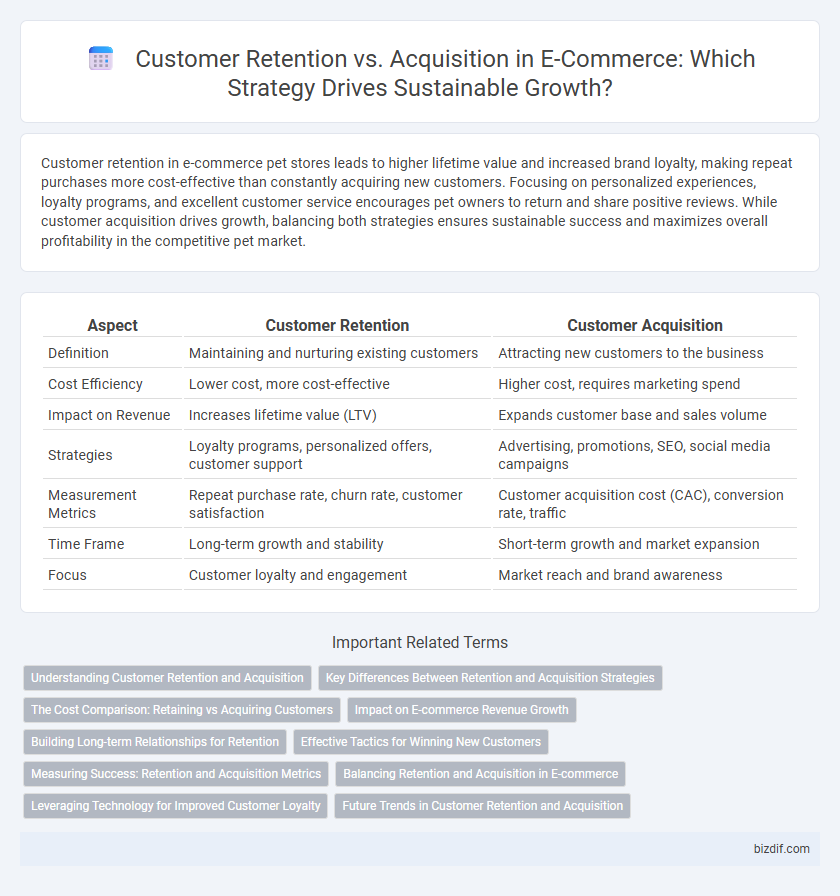Customer retention in e-commerce pet stores leads to higher lifetime value and increased brand loyalty, making repeat purchases more cost-effective than constantly acquiring new customers. Focusing on personalized experiences, loyalty programs, and excellent customer service encourages pet owners to return and share positive reviews. While customer acquisition drives growth, balancing both strategies ensures sustainable success and maximizes overall profitability in the competitive pet market.
Table of Comparison
| Aspect | Customer Retention | Customer Acquisition |
|---|---|---|
| Definition | Maintaining and nurturing existing customers | Attracting new customers to the business |
| Cost Efficiency | Lower cost, more cost-effective | Higher cost, requires marketing spend |
| Impact on Revenue | Increases lifetime value (LTV) | Expands customer base and sales volume |
| Strategies | Loyalty programs, personalized offers, customer support | Advertising, promotions, SEO, social media campaigns |
| Measurement Metrics | Repeat purchase rate, churn rate, customer satisfaction | Customer acquisition cost (CAC), conversion rate, traffic |
| Time Frame | Long-term growth and stability | Short-term growth and market expansion |
| Focus | Customer loyalty and engagement | Market reach and brand awareness |
Understanding Customer Retention and Acquisition
Customer retention focuses on maintaining existing customers by enhancing satisfaction and loyalty, leading to increased lifetime value and repeat purchases. Customer acquisition involves attracting new customers through marketing strategies and promotional campaigns, which often requires higher costs compared to retention efforts. Balancing retention and acquisition is crucial for sustainable e-commerce growth, as loyal customers generate consistent revenue while new customers expand the market base.
Key Differences Between Retention and Acquisition Strategies
Customer retention strategies focus on enhancing customer loyalty through personalized experiences, reward programs, and consistent engagement, leading to higher customer lifetime value and reduced churn. In contrast, customer acquisition strategies prioritize expanding the customer base by leveraging targeted advertising, SEO, and promotional campaigns to attract new buyers. Retention efforts typically incur lower costs and generate sustainable revenue, while acquisition demands significant marketing investment and drives initial sales growth.
The Cost Comparison: Retaining vs Acquiring Customers
The cost of retaining customers is significantly lower compared to acquiring new ones, with retention expenses averaging 25-30% of acquisition costs. Loyal customers typically generate 40-60% of a company's revenue while requiring fewer marketing resources and lower discount incentives. Investing in customer retention strategies such as personalized communication, loyalty programs, and exceptional support can yield a higher return on investment (ROI) than aggressive acquisition campaigns.
Impact on E-commerce Revenue Growth
Customer retention drives sustainable e-commerce revenue growth by increasing customer lifetime value and reducing acquisition costs, with repeat customers generating 60-70% of total sales. In contrast, customer acquisition incurs higher expenses, often costing five times more than retention efforts, yet is essential for expanding market share. Balancing retention strategies like personalized marketing and loyalty programs with targeted acquisition campaigns maximizes overall revenue efficiency and long-term profitability.
Building Long-term Relationships for Retention
Building long-term relationships in e-commerce enhances customer retention by increasing lifetime value and reducing churn rates. Personalized communication, loyalty programs, and exceptional post-purchase support foster trust and repeat business. Investing in retention strategies significantly lowers marketing costs compared to acquiring new customers and drives sustainable growth.
Effective Tactics for Winning New Customers
Targeted advertising campaigns leveraging data analytics increase customer acquisition efficiency by reaching specific demographics with personalized offers. Implementing referral programs incentivizes existing customers to bring in new buyers, boosting acquisition rates cost-effectively. Optimizing the user experience on mobile platforms with streamlined checkout processes reduces friction and increases conversion rates among new customers.
Measuring Success: Retention and Acquisition Metrics
Customer retention metrics such as repeat purchase rate, customer lifetime value (CLV), and churn rate provide insights into loyalty and long-term profitability. Acquisition metrics including customer acquisition cost (CAC), conversion rate, and average order value (AOV) evaluate the efficiency of attracting and converting new customers. Comparing these metrics helps e-commerce businesses optimize marketing strategies by balancing investment between acquiring new customers and nurturing existing ones for maximum growth.
Balancing Retention and Acquisition in E-commerce
Balancing customer retention and acquisition in e-commerce requires strategic investment to maximize long-term profitability while expanding the customer base. Retention efforts, such as loyalty programs and personalized marketing, increase lifetime value and reduce churn, whereas acquisition drives revenue growth through targeted advertising and promotions. Optimizing the blend of these strategies enhances overall customer engagement and sustainable growth.
Leveraging Technology for Improved Customer Loyalty
Leveraging advanced CRM systems and AI-driven analytics enables e-commerce businesses to personalize customer experiences, increasing retention rates by targeting specific preferences and behaviors. Automated loyalty programs integrated with mobile apps enhance engagement through tailored rewards and seamless interactions, boosting lifetime customer value. Implementing chatbots and real-time support reduces churn by resolving issues promptly, creating a consistent and satisfying user experience that fosters long-term loyalty over new customer acquisition.
Future Trends in Customer Retention and Acquisition
Emerging technologies such as artificial intelligence and machine learning are revolutionizing customer retention by enabling hyper-personalized marketing and predictive analytics to anticipate customer needs. Future trends emphasize the integration of omnichannel strategies, combining social media, mobile apps, and AR/VR experiences to create seamless acquisition and retention journeys. Data-driven insights and automation will increasingly optimize customer lifetime value, reducing acquisition costs while enhancing loyalty through tailored engagement.
Customer Retention vs Customer Acquisition Infographic

 bizdif.com
bizdif.com